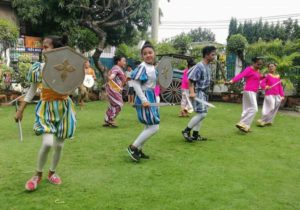
Members of Turang Dance Troupe perform the traditional “Sinug” dance ritual at Casa Gorordo Museum in Parian, Cebu City, as taught to them by the descendants of Estelita “Nang Titang” Diola who was known as the “Keeper of the Sinulog Beat.”
CDN PHOTOS/CHRISTIAN MANINGO
It was the beat of the drum that started it all: The Diola family tradition to perform the “Sinug” dance ritual at the Casa Gorordo located in the district of Parian, Cebu City.
Right there in the house of Juan Gorordo, the first native Cebuano bishop of Cebu, the Diolas began their family tradition in the 1930’s as a way to honor Santo Niño.
A huge drum, locally known as “tambol,” made of bronze and wood covered in goatskin sewn with abaca fiber, has been witness to their Sinug dance ritual for generations.
“Labaw pa sa akong kinabuhi kay importante ni namo. Kung mawala ni, mawala sad ang among Sinulog (This drum is more important than my life. If this is gone, then our Sinulog tradition would come to an end),” said 47-year-old Rommel Diola as he talked about the family’s centuries-old musical instrument which he inherited from his ancestors.
Rommel is the grandson of the late Estelita “Nang Titang” Diola who was known as the “Keeper of the Sinulog Beat.”
It was Nang Titang who successfully preserved the dance form through several decades of dancing to the beat of her family’s drum while inspiring others to follow.
The forward-backward movement of the Sinulog dance, which resembles the current (sulog) of what was known as Cebu’s Pahina River, was learned by Nang Titang at the age of seven from her father, Buenaventura.
Sinug traditional dance
The traditional form of dancing Sinulog is well preserved even to this day, along with the catchy beat composed by Buenaventura’s friend, Mariano “Iklot” Bontilao.
Rommel, caretaker of the family’s tambol, has been teaching the traditional dance ritual to children in their neighborhood along Barangay Mabolo.
At the age of nine, he learned to play the Sinug’s olden beat on the family’s drum from his grandmother, Nang Titang, whom he remembers saying, “Ampingi ang Sinug. Pakamatyi. kay kini wala sa uban, kita ra naa ani (Take good care of the Sinug. Die for it because it is only us who have this).”
Nang Titang, a devotee of the Santo Niño, passed away in 2013 at 88 years old.
But her family has made certain that the traditional Sinulog will live on forever through generations of other Diolas.
Big shoes to fill
67-year-old Carolina Diola, is now filling in the shoes of her aunt, Nang Titang as “Keeper of the Sinulog Beat” and lead dancer of the family’s 45-minute annual Sinug presentation at Casa Gorordo.
As she led around 40 members of Turang Dance Troupe, a group of Sinulog dancers named after her grandfather, Buenaventura, Carolina said that this year’s presentation was different compared to the other times she led the group since Nang Titang’s death in 2013.
She said her aunt visited her in a dream and they both danced the Sinug: Two steps forward, one step backward, with their hands outstretched in homage to the Holy Child.
“My aunt said that I should continue this even if I feel like I don’t anymore want to. This is a big responsibility to handle,” Carolina said in Cebuano as she recounted her dream.
Despite the modern and enhanced Sinulog rhythm used in Cebu’s annual Sinulog parade, Carolina said that Nang Titang’s descendants will keep the dance’s traditional rhythm and beat.
“There are changes every year; but I haven’t changed any of our dances and even the beat,” Carolina said.
The Diolas perform Sinug with a dance format which starts with “Llamada,” when the drum beater calls on the performers to gather and prepare for the ritual.
When the performers have already gathered, they then do the “Repaso” or a form of march to signal the start of the prayer dance ritual.
The dancers then perform “Alabaccion” which is a prayer dance for gratitude, departed souls and to ward off calamities by imploring the help of Santo Niño.
In between these, dancers chant “Pit Señor”, the short form of “Sangpit sa Señor” which in Cebuano means “to plead to the king.”
Monday’s Sinug performers at Casa Gorodo were mostly children wearing colorful costumes depicting the roles of Cebuano natives and Spanish conquerors in a “war dance” culminating in the people’s submission to Christianity and the Santo Niño.
The youngest performer was Carolina’s grandson, two-year-old Angelo Ababan.
The Sinug dance ritual in Bishop Gorordo’s two-storey house, now known as the Casa Gorordo Museum, happens on Monday after the feast of the Santo Niño de Cebu, every third Sunday of January.
The historic house was acquired by the Ramon Aboitiz Foundation Inc. (RAFI) in 1980.
“Part of our (RAFI) pledge to the Gorordo family is to continue the house tradition, in terms of having the Sinug performance in the Casa,” said museum curator, Florencio Moreño.
And so while there may be changes here and there in Cebu’s annual Sinulog festival, expect the old Sinug dance in its traditional form to last for generations to come as Nang Titang’s legacy is ever constant — just like the steady flow of a river.
Disclaimer: The comments uploaded on this site do not necessarily represent or reflect the views of management and owner of Cebudailynews. We reserve the right to exclude comments that we deem to be inconsistent with our editorial standards.
